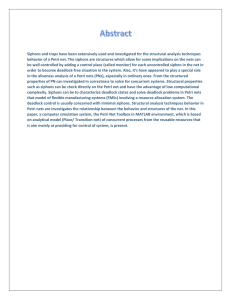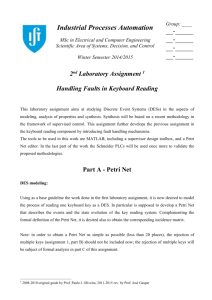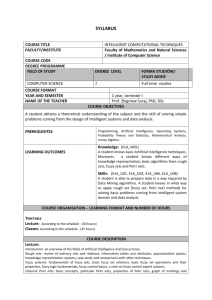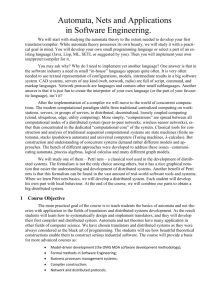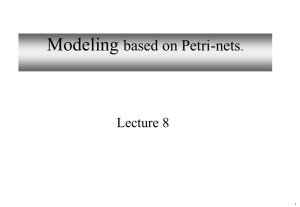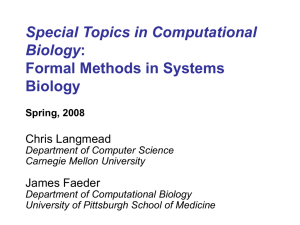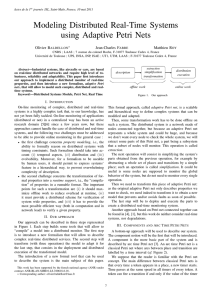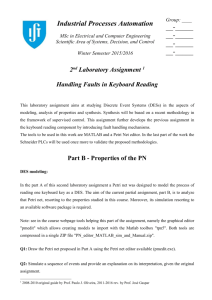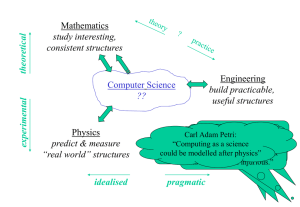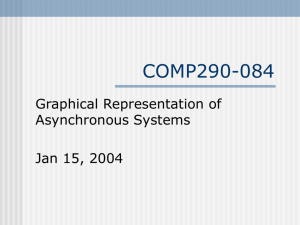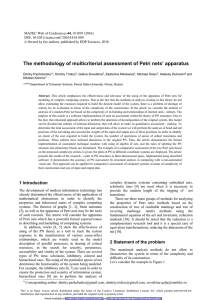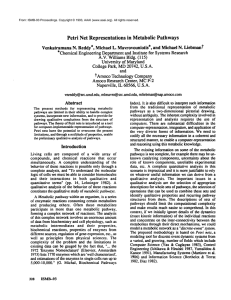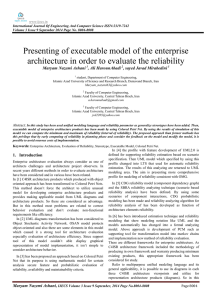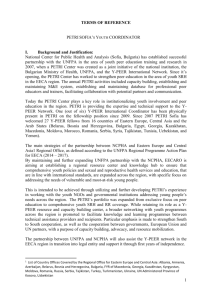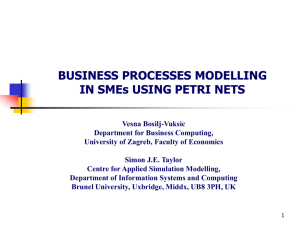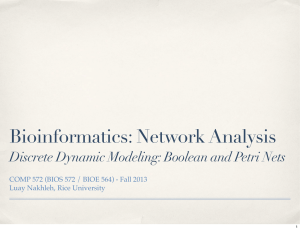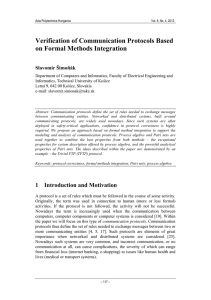Decidability of Minimal Supports of S
advertisement
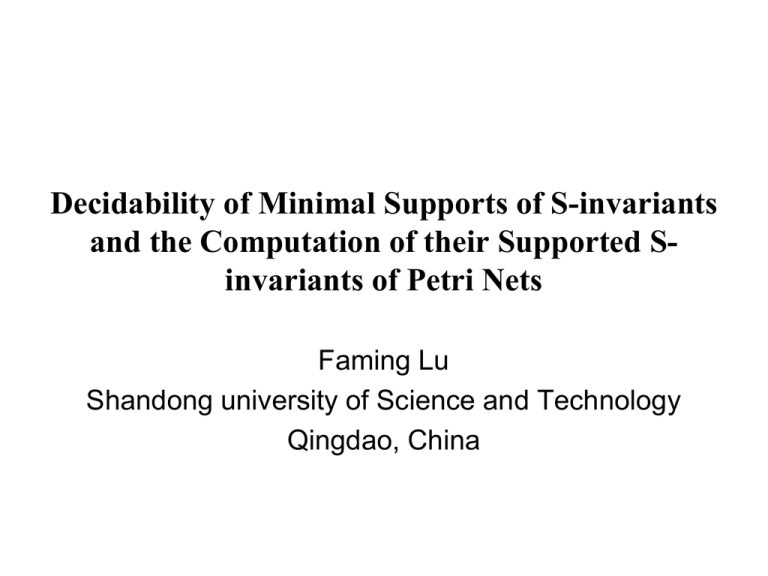
Decidability of Minimal Supports of S-invariants
and the Computation of their Supported Sinvariants of Petri Nets
Faming Lu
Shandong university of Science and Technology
Qingdao, China
Outline
• Basic concepts about Petri nets and S-invariants
• Review about the computation of S-invariants
• Main conclusions of this paper
• Outlook on the future work
• Q&A
Basic concepts
• Petri net
A Petri net is a 5-tuple (S ,T ; F ,W , M ) , where S is a finite set of
places, T is a finite set of transitions, F S T (T S ) is a set
, }
of flow relation, W : F 1,2,3,... is a weight function, M 0 : S {01,2,
is the initial marking, and S T S T
Graph representation & incidence matrix
0
t1
2
t2
s2
2
s1
t4
t3
s3
s4
s5
s6
Fig 1. A Petri net example ∑1
2 1 0 0 1 0
0 1 1 0 0 1
A
0 0 1 1 1 0
2
0
0
1
0
1
the incidence matrix of∑1
Basic concepts
• S-Invariants & supports of S-invariants
An S-invariant is a non-trivial integral vector Y which satisfies
AY 0 , where A is an incidence matrix of a Petri net
An support of S-invariant Y is the place subset generated by
Y s j S Y ( j ) 0 , where S is the place set of a Petri net.
Examples:Y1, Y2 and Y3 are all S-invariants. ||Y1|| and ||Y2|| are
two minimal supports while ||Y3|| is a support but not a minimal
support because ||Y1||=||Y1||∪||Y2|| .
Y1 1 2 2 2 0 0 , Y1 s1 , s2 , s3 , s4
T
Y2 1 0 1 0 1 1 , Y2 s1 , s4 , s5
T
t1
Y3 2 1 1 1 1 2 , S3 s1 , s2 , s3 , s4 , s5
T
2
t2
s2
2
s1
t4
t3
s3
s4
s5
s6
Fig 1. A Petri net example ∑1
Review about S-invariants Computation
• reference [1]: no algorithm can derive all the S-invariants in
polynomial time complexity.
• Reference [5]: a linear programming based method is presented
which can compute part of S-invariant’s supports, but integer Sinvariants can’t be obtained
• References [6-7]: a Fourier_Motzkin method is presented to
compute a basis of all S-invariants, but its time complexity is
exponential.
• References [8-9]:a Siphon_Trap based Fourier_Motzikin method
which has a great improvement in efficiency on average, but
there are some Petri nets the S-invariants of which can’t be
obtained with STFM method and the the time complexity is
exponential in the worst case.
• This paper: two polynomial algorithms for the decidability of a
minimal support of S-invariants and for the computation of an Sinvariant supported by a given minimal support are presented.
Main Conclusions
• Judgment theorem of minimal supports of S-invariants
Let be an arbitrary non-trivial solution of AS YS 0 . Place subset
S1 is a minimal support of S-invariants if and only if R( AS1 ) S1 1
and is positive or negative, where AS1 is the generated sub-matrix of
A corresponding to S1 .
Examples: considering 1 and S2 s1 , s4 , s5 in Fig.1. After the
following elementary row transformation, we can see that =[0.5 1]T
is an positive solution and R( AS2 ) 4 S2 1 . According to the above
theorem, S2 is an minimal support, as is consistent with the facts.
1
2 0 1
2
0 0 0 r4 r1 0
r4 r3
AS2
0 1 1
0
2
1
0
0
1
0 0
1 1
0 0
2
0
1
t2
t1
s2
2
s1
t4
t3
s3
s4
s5
s6
Fig 1. A Petri net example ∑1
Main Conclusions
•Decidability algorithm of a minimal support of S-invariants
2
O S1 T
Main Conclusions
•Construction of a non-trivial integer solution for AS YS 0
1
1
Examples:
2 0 1
2 0
1
C
D 0 1 j 3 C3 1
0
1
1
2 0
1 0
yS2 :3 det( D)
2 yS2 :1 det( D1 C3 )
1;
0 1
1 1
yS2 :2 det( D2 C3 ) 2 YS2 1 2 2 YS2 1 YS2 1 2 2
T
Y 1 0 0 2 2 0
T
T
Main Conclusions
•Computation of a minimal-supported S-invariant
O(| S1 |2 | T | | S1 |4 )
Outlook on the future work
•Based on the conclusion presented in this paper, we have
realized the following algorithm with Matlab:
– (1)An algorithm used to judge the existence of S-invariants and generate
one S-invariant if it exist, which is a polynomial time algorithm on average.
Running Time(Unit:100seconds)
Number of Place s/Transitions
Petri nets with (|T|*|S|)/3 flows on average
Petri nets with 2*(|T|*|S|)/3 flows on average
The running time statistics of the above algorithm
Outlook on the future work
– (2)An algorithm used to judge the S-coverability of a Petri net and
generate a group of corresponding S-invariants, which is a polynomial
time algorithm on average too.
Running Time(Unit:100seconds)
Number of Place s/Transitions
Petri nets with (|T|*|S|)/3 flows on average
Petri nets with 2*(|T|*|S|)/3 flows on average
The running time statistics of the above algorithm
Q&A
• Any questions, please contact fm_lu@163.com
• Thank you!
